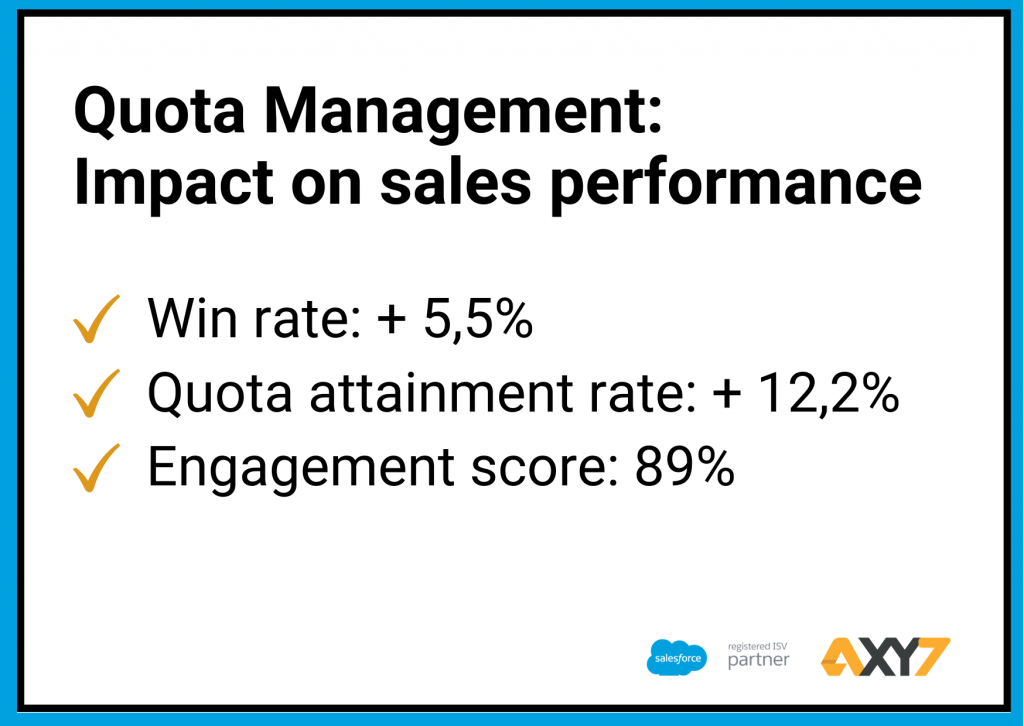Maximizing Sales Performance with Sales Quota Management in Salesforce
As a sales manager, achieving your sales quota is a critical component of success. Setting clear, achievable goals and tracking progress towards those goals is essential to drive results and meet business objectives. Salesforce is a powerful tool that can help sales teams and managers to manage their quotas and maximize performance.
The Power of Quota Management: Proven Benefits and Impacts on Sales Performance:

There is a wealth of data and research available that highlights the benefits of quota management and its impact on sales performance. Here are some key statistics that demonstrate the positive impact of quota management on sales outcomes:
- A study by CSO Insights found that companies that have formalized quota management processes have a 5.5% higher win rate than those that do not.
- Another study by Achievers found that companies with formalized quota management processes have a 12.2% higher sales quota attainment rate compared to those that do not.
- Research by Salesforce found that sales organizations that use formalized quota management processes are more likely to meet or exceed their sales targets, with an average attainment rate of 115%.
- Additionally, the same study found that organizations that use formalized quota management processes have a higher level of sales team engagement, with an average engagement score of 89%.
Best Practices for Managing Monthly vs Quarterly Quotas
Quotas can be set on a monthly or quarterly basis, and both approaches have their advantages. Monthly quotas are useful for tracking progress and making adjustments in real-time, while quarterly quotas provide a longer-term perspective and help to align with company goals and objectives. Regardless of the time period, there are a few best practices to follow when managing quotas in Salesforce:
- Set realistic and achievable goals: Quotas should be challenging, but achievable. It is important to consider factors such as market conditions, sales trends, and the performance of individual sales representatives when setting quotas.
- Communicate goals clearly: Ensure that sales representatives understand their quotas and the expectations around meeting those quotas. Communication is key to driving results and achieving success.
- Monitor progress regularly: Regularly track progress towards the quota and make adjustments as needed. This helps to ensure that quotas remain realistic and achievable and that sales representatives are on track to meet their goals.
- Provide incentives and recognition: Recognizing and rewarding sales representatives for meeting their quotas can help to drive motivation and performance. Consider offering bonuses or other incentives for achieving quotas, or for exceeding them.
Maximizing Sales Success with Regional Quotas and OKRs:
Quota management is a critical aspect of sales performance, and regional quotas can be an effective way to tailor sales goals to the unique needs and opportunities of different areas. For example, let’s say a business has a total sales quota of $20 million. By splitting this quota by region, the North Region is assigned a quota of $4.5 million for Q1.
To achieve this quota, sales teams in the North Region may set OKRs that align with this goal, such as increasing customer outreach or expanding the customer base in specific industries. By tracking progress towards these objectives, sales teams can stay focused and motivated, and managers can make informed decisions to drive performance.
Using OKRs based on regional quotas allows businesses to set and track specific targets for each area, helping to ensure that sales goals are tailored to the unique needs and opportunities of each region. By breaking down larger quotas into targeted, achievable goals, sales teams can work towards driving success and growth for the business as a whole.
Managing Quotas in Salesforce CRM
Salesforce provides a powerful platform for managing sales quotas and tracking progress toward those quotas. Sales teams and managers can use Salesforce’s reporting tools to gain a comprehensive view of sales performance and to make informed decisions about quota management.
Recommended Reports for Managing Quotas in Salesforce
There are several reports in Salesforce that can be used to manage sales quotas, including:
- Opportunity Report: This report provides a comprehensive view of the sales pipeline, including the number and value of opportunities, their stage, and expected close dates.
- Quota Attainment Report: This report provides a snapshot of the sales team’s progress towards their quota, including the amount of quota achieved and the amount remaining.
- Sales Forecast Report: This report provides a view of the expected revenue and the likelihood of hitting sales targets. It allows sales teams to see the expected outcome based on the deals in their pipeline.
- Sales Performance Report: This report provides a view of individual sales performance against quotas, including the number and value of deals won, the amount of quota achieved, and the amount remaining.
- Trend Report: This report provides a view of sales performance over time, allowing sales teams and management to see trends and patterns in sales performance.
By utilizing these reports, sales teams and management can have a clear and comprehensive view of sales performance and quota attainment, allowing for informed decision-making and continuous improvement. It is important to regularly review and adjust quotas based on insights gained from these reports.
Translating Quotas into Objectives and Key Results (OKRs)
The benefits of using quotas and an integrated OKR tool in Salesforce are significant. Quotas provide a clear and measurable goal for sales representatives to focus on, and tracking progress towards those quotas helps to keep sales efforts aligned with business objectives.
By integrating OKRs into the quota management process, sales teams can align their goals and efforts with the broader business objectives and outcomes. OKRs provide a clear and measurable way to track progress and impact, and can be used to drive motivation and engagement among sales teams.
In Salesforce, the combination of quota management and OKR tools provides a comprehensive and integrated approach to sales performance management. Sales teams and management can track progress toward sales quotas and business objectives in real-time, and make data-driven decisions about how to optimize performance. This helps to drive results and improve sales outcomes, ultimately driving business growth and success.
In conclusion, using Salesforce’s quota management and OKR tools provides a powerful way for sales teams and management to maximize sales performance and achieve business objectives. By setting clear and achievable goals, tracking progress, and making informed decisions, sales teams can drive results and achieve success.
Unlock the full potential of your sales team with Axy OKR and Salesforce Integration. Get real-time progress tracking and improve collaboration. Click here to schedule a demo.



